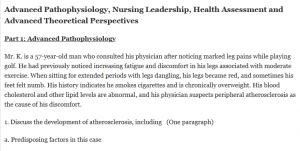Advanced Pathophysiology, Nursing Leadership, Health Assessment and Advanced Theoretical Perspectives

Part 1: Advanced Pathophysiology
Mr. K. is a 57-year-old man who consulted his physician after noticing marked leg pains while playing golf. He had previously noticed increasing fatigue and discomfort in his legs associated with moderate exercise. When sitting for extended periods with legs dangling, his legs became red, and sometimes his feet felt numb. His history indicates he smokes cigarettes and is chronically overweight. His blood cholesterol and other lipid levels are abnormal, and his physician suspects peripheral atherosclerosis as the cause of his discomfort.
1. Discuss the development of atherosclerosis, including (One paragraph)
a. Predisposing factors in this case
b. Pathophysiological changes.
2. Discuss the complications that might develop in this patient. (One paragraph)
a. Pathophysiology
b. Signs
c. Symptoms.
3. Discuss the treatments for all aspects of the patient’s condition, including (One paragraph)
a. Slowing the progress of the atherosclerosis
b. Maintaining circulation in the leg
c. Treating complications.
Part 2: Advanced Pathophysiology
Mr. F is a 38-year-old man in overall good health who has been complaining about an aching pain in his knees when working around the house and often when simply walking. He has noticed that his knees feel “hard” and tight. His history indicates that he has always been involved in athletics and was on the college football team, but recently family responsibilities and work have not made it easy for him to exercise.
1. Relate Mr. F’s case history to the pathophysiology of osteoarthritis (One paragraph)
2. How do anti-inflammatory drugs and analgesics help Mr. F deal with this form of arthritis? (One paragraph)
a. Why is moderate, non–weight-bearing exercise recommended?
3. What is the probable prognosis for Mr. F? (One paragraph)
Part 3: Nursing Leadership
Many people have problems with changes. Nurses need to deal with changes every day.
1. How do you deal with changes? (Two paragraphs)
2. Tell me three good reasons for changes? (one paragraph)
Part 4: Health Assessment
Six paragraphs pe page********************
A 40-year-old housewife complains of progressive weight gain of 20 pounds over the last year, fatigue, postural dizziness, loss of memory, slow speech, deepening of her voice, dry skin, constipation, and cold intolerance. She claims her menses have been irregular in the last year. She has an 18-year-old daughter and has been trying to have another child with her new partner but has been unsuccessful.
1. (No list format) What questions you would ask the patient
2. What physical 3xam elements you would include
3. What further testing you would want to have performed.
****In SOAP format, list:******
4. Pertinent positive findings that validate your main diagnosis
5. Pertinent negative findings that make you think of other differential diagnoses
6. Treatment plan, including
a. Pharmacotherapy with complementary
b. OTC therapy
c. Diagnostics (labs and testing)
d. health education and lifestyle changes
e. Age-appropriate preventive care, and follow-up to this visit.
Initial post must have a minimum of 300 words, excluding references.
Part 5: Advanced Theoretical Perspectives
Making judgement as to whether a theory could be adapted for use in research is very important.
1. What is internal and external criticism (One paragraph)
2. Describe the internal criticism that is used to evaluate middle range theories.(One paragraph)
3. Describe the external criticism that is used to evaluate middle range theories.(One paragraph)